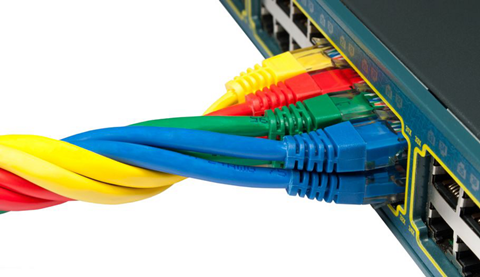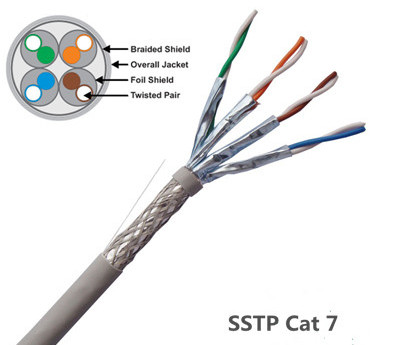Is It Worthwhile to Use Cat 7 Ethernet Cable?
utorak , 23.08.2016.Ethernet cables provide stable internet connection between electrical devices, which are standardized cables to facilitate easy communication between disparate electronic equipment. These electronic devices can either be fax machines, printers, scanners, or personal computers. Ethernet cables can be categorized into several types based on different specifications. Category 7 Ethernet cable, also refers to Cat 7, which is the wire used for cabling infrastructure of Gigabit Ethernet. it is known that Cat7 is the more expensive option compared to Cat 5e and Cat 6 cables. Users might be wondering whether it is worth the extra money to consider Cat 7 cables. The answer to this solution will be clearly introduced in this passage.

Quick Review of Cat 7 Cables
The Cat 7 cable refers to the transmission cord standard cable used in the 10G Ethernet and other Cat 5/Cat 6 downhill compatible networks. The Cat 7 cable is an 8-core safeguarded cable that each pair of cable has a shield. The program of Cat 7 cables is incompatible with RJ45. A Cat 7 cables can offer performance of up to 600MHz, which is 6 times as fast as cat 5e and 2. 4 times as fast as cat 6. Besides this, Cat 7 cable, whilst being the more expensive option, is also considered the most durable, and has a longer lifespan than Cat 5 and Cat 6, improving its overall return on investment, and is the best choice for wiring with the future in mind.
Comparing Cat 7 Ethernet Cable With Cat 5/Cat 6 Cables
The mostly used Ethernet cables are not a brand name or , they are separated into different standard categories like Cat 5, Cat 5e, Cat 6 and Cat 7. Each one of them is backward compatible, meaning that you can plug a newer cable into a device created for a slower cable, and you will not have any compatibility problems. For companies that are still using the older Ethernet cables, maybe it is time for them to upgrade to a newer version. Cat 7 as the newly released category, opposes the better performance than the former Category Ethernet cables. The following chart shows the distinctions in different Ethernet Categories.

Cat 7 cables requires its twisted wires to be fully shielded known as Screen Shielded Twisted Pair (SSTP) or Screened Foiled Twisted Pair (SFTP) wiring, which completely eliminates alien crosstalk while significantly improving noise resistance. Thus it allows the user to get higher possible speeds even with longer cables. When compared at lengths of 100 meters of cable, the following numbers show the difference in Ethernet cable categories:
Cat 5 Ethernet cable is typically too slow for business networks, allowing the user to transmit up to 100 Mb/second speed at 100 Mhz. Cat 5e Ethernet cable allows up to 1 Gb/s internet speed with 100 Mhz. Cat 6 Ethernet cable allows up to 1 Gb/s, but cable lengths up to 55 meters can get internet speeds of 10 Gb/s at 250 Mhz. Cat 7 Ethernet cable is the newest cable category, operating at speeds of 10 Gb/s at 100 meters of cable and transmitting frequencies up to 600 Mhz.
Why Implementing Cat 7 Cable?
As noted before, Cat 7 cable is able to achieve higher transmission speed and longer distances than the preceding Ethernet cables like Cat 5, Cat 5e, and Cat 6 cables. What’s more, Cat 7 has an overall shield as well as individual shielding of every pair. Therefore it is much more resilient to interference compared to a CAT 5 cable. The following picture shows a SSTP Cat 7 cable.

To better meet the future demand, Cat 7 cables is an dispensable solution as it can create an expandable and flexible cabling system which will save you the expense of re-wiring for new features in the future! One point that we shouldn’t miss out is that Cat 7 cable has a copper cross-section than the Cat 5, which means the individual cores in Cat 7 are easier to work with. Then opt for Cat 7 cables will benefit you a lot.
Solid or Stranded Ethernet Cables
This refers to different methods the wires used within the cable. The solid cable uses one single piece of copper for an electrical conductor. The stranded cable uses multiple (and thinner) copper cables twisted together for the electrical conductor. This makes the stranded cable more flexible, perfect for navigating a complex space. The solid cable is far less flexible making it ideal for permanent installation in the walls or outdoor. This wiring method is not suitable for fiber optic cables like ST-LC patch cord.
Our Recommendations
In summary, careful planning and product selection will be the key to a successful installation. Resolution, distance, signal types, environment, and physical layout are the important factors that you should consider when choosing a transmission media. Cat 7 cable can support 10 Gigabit Ethernet with plenty of margin to spare, and it has pair-sharing capability, making it possible to use one cable to power several different devices at the same time utilizing each pair as needed. FS.COM offers the best and most versatile copper cables including Cat 5e, Cat 6 and Cat 7 products. Fiber optic cables are provided as well. Fiber patch cables LC to LC, LC LC single mode fiber patch cable, and SC to LC patch cable are all offered at minimum price. If you have any interest, please send your request to us.
Oznake: Cat7, Cat5, Cat6, Cat5e, Ethernet cables
komentiraj (0) * ispiši * #
Cat6 vs. Cat6a Cable
petak , 15.04.2016.Probably network designers who work in telecommunication industry are often met such questions in cabling installation: which cable type performs better and why is it. Some cabling installers even argue against each other and keep their own instances on the better cable type that they think is suitable for the projects. Cat6 and Cat6a are just in this case, since the selection of them leads to different opinions among users. Some prefer to the Cat6, while some choose the Cat6a. In this article, several aspects will be discussed to differ these two kinds, with the aim to help you choose the right cable type for your networking use more quickly.
Both Cat6 and Cat6a are unshielded twisted pair UTP or shielded twisted cables, suitable for Gigabit Ethernet (GbE) and other network physical layers. They are backward-compatible with Cat3, Cat5 (a cable type widely used in GbE applications in combination 1000BASE-T SFPs, eg. Cisco SFP-GE-T). Each deploy four twisted pairs in a common jacket to transmit data by using the same style RJ-45 jacks and plugs. When compare Cat6 with Cat6a, it seems that the only difference lie in the single lowercase letter—a standing for “augmented” that sets the two apart. However, differences are not limited to this one point.
Cat6 vs. Cat6a: Physical Properties
Firstly, Cat6 and Cat6a have their own identifiers printed on the cable jacket itself, so this provides a quick way to tell them apart. Secondly, Cat6a is thicker and bulkier than Cat6 just looking from outside. Thirdly, in terms of wiring structure, Cat6 is made of tightly twisted pairs of copper wires with extra insulation to reduce crosstalk, while Cat6a takes things even further by additionally twisting each pair around a flexible central plastic support.
Cat6 vs. Cat6a: Speed & Distance
It’s known that Cat6 and Cat6a are all designed for GbE and other standard network protocols, both being suitable for 10BASE-T, 100BASE-TX, 1000BASE-T, and 10GBASE-T. (Certainly, 1000BASE-T standard can also operate over Cat5 cables, such as GLC-T SFP.) At first sight, there is no big difference. But the real points come when you consider their transmission speed and distance. Cat6 cable is rated for 250MHz, and when used for 10GBASE-T applications, the maximum length maximum length ranges from 33m to 55m. In contrast, Cat6a doubles that capability by performing at up to 500MHz, allowing 10GBASE-T to be run over longer distances of up to 100m.
Cat6 vs. Cat6a: Crosstalk
Crosstalk happens when a signal from one channel or circuit interferes with another channel or circuit's signal. Cat6a has a lower-level crosstalk than Cat6a. Such reduction owes to alien crosstalk (AXT), which refers to the cables interfering with the signals of other cables in close proximity. This AXT pehnomenon is significant in Cat6 which is exposed to high frequencies, but quite low in Cat6a.
Cat6 vs. Cat6a: Durability
Due to the new central column support and ubiquitous shielding, Cat6a is much heavier and bulkier than the Cat6 just as what has been mentioned above. Cat6a takes more room, so that cable trays will not hold nearly as many Cat6a cables as they can for Cat6 cables.
Although Ethernet cables may seem sturdy on the outside, their inner parts are so fragile. To put in in another way, it is ill-advised to bend cables or cause winding of cables too much, as this can damage wiring and lead to performance degradation. Because of their bulkiness, Cat6a cable has a smaller bend radius than Cat6 cable.
Cat6 vs. Cat6a: Cost
Compared with Cat5e cables, Cat6 and Cat6a cables are more expensive, which mainly dues to the cabling length. But the cost differences between Cat6 and Cat6a cables are not so distinctive, or in other words, relatively small. For example, 5m Cat6 twisted pair patch cable sells at US$ 6.10 in Fiberstore, and the same length of Cat6a twisted pair patch cable in Fiberstore costs US$ 7.70.
Conclusion
In a word, Cat6a permits longer transmission distance for 10GbE applications and reduces crosstalk, but it’s bulkier and heavier in weight than Cat6. When you feel at a loss about whether to choose Cat6 or Cat6a cable, it’s necessary to outweigh the virtual points against weaknesses for your specific applications, then you can make a wise choice. Fiberstore offers various Ethernet cables for your copper networks, including Cat5, Cat6, Cat6a, and so on. For more information about Cat cables, you can directly connect me at Linkedin @Fern Xu (Fiberstore).
komentiraj (0) * ispiši * #



